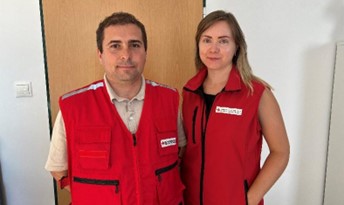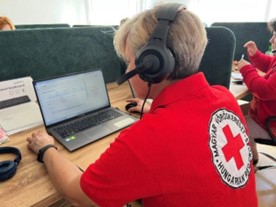In the realm of humanitarian aid and disaster response, staying connected with affected communities is not merely a logistical challenge but a moral imperative. Ensuring that those impacted by crises can make their voice heard and access the assistance they need is at the heart of the work of the Red Cross Red Crescent Movement. To fulfill this objective, last year, lead by the IFRC, the Hungarian Red Cross together with 510، مبادرة البيانات والرقمية للصليب الأحمر الهولندي, started implementing the Digital Engagement Hub (DEH) in response to the conflict in Ukraine and the subsequent large-scale population movement into Hungary. The tool bridges the gap between humanitarian actors and people affected by disasters and crises, provides essential information, and supports handling the challenges people face in registering for cash and voucher assistance.
In the midst of crisis, the digital helpdesk became a very important tool for those in need during the Ukraine response to be heard and getting assistance. It’s not just technology; it’s a lifeline that bridges distances, connects hearts, and delivers aid to the most vulnerable.
Fatma Nur Bakkalbasi (Community Engagement and Accountability Delegate, IFRC)
The Digital Engagement Hub
At the heart of the Digital Engagement Hub (DEH) lies a simple yet profound concept: creating a bridge between those in need of help and those who can provide it. In essence, it is a standardized technological solution designed to facilitate digital and omni-channel communication between humanitarian actors and people affected by a crisis. It was build including Twilio which is software helping people communicate with each other over multiple channels, allowing them to send messages and make phone calls.
DEH acts as the nerve center for communication, enabling helpdesk operators to receive feedback, answer questions, and provide vital information. It ensures that affected populations are not passive recipients but active participants in shaping their recovery. In Hungary, DEH has taken the shape of a helpdesk which helps people who had to leave Ukraine with any issues they might run into while registering for the cash and voucher assistance program through which cash is provided weekly to those who are eligible. In addition, it refers people on topics such as food, clothing, shelter, and legal information.
The Hungarian Red Cross chose to implement DEH to supplement a channel to communities to reach them regarding the services and programs. This system streamlines the provision of counseling in three different languages through relevant channels such as Viber and calls. Impacted people can call to leave a message to which the Hungarian Red Cross responds within 24 hours or on the next working day, establishing a direct, personalized line of communication to address their needs. >Within four months after launching in Oct 2022, the virtual helpdesk’s three agents dealt with over 2,300 cases.
Hungarian Red Cross Helpdesk team
The Helpdesk team in Hungary consists primarily of people who used to live in Ukraine themselves and had to leave their country because of the conflict. Neither of them had worked at a helpdesk before, but all of them wanted to help ease the situation for those who had to leave their home behind.
Ilona, Helpdesk Agent:
“I know the challenges they face because I’ve walked that path myself. When I help refugees from Ukraine, I see their resilience and strength, and it reminds me of my own journey.”
Mariana, Helpdesk Agent:
“It feels very good to be able to help. The tool makes it easy to connect with people and to provide this help, to give them the right information, support their registration challenges for the cash program and share their feedback with the right people.”
Maryna, Helpdesk Supervisor:
“As someone who had to leave Ukraine myself, I take immense pride in helping other people. Our shared experiences help us to provide compassionate and empathetic support to fellow refugees from Ukraine.”

Unveiling the Features
Central to DEH’s prowess is its ability to enable multi-channel communication. Through the platform, people affected can engage with humanitarian actors in real time. This not only facilitates information sharing but also bridges language barriers and accessibility gaps, ensuring that every voice is heard.
But communication is only part of the equation. DEH goes beyond mere interaction by utilizing data analytics to transform feedback into actionable insights. By analyzing the information gathered through the channel, humanitarian organizations can make informed decisions, allocate resources more efficiently, and tailor their interventions to meet specific needs.
Furthermore, the tool places a strong emphasis on localization and cultural sensitivity. Recognizing that every crisis is unique and that different cultural contexts demand different approaches, DEH ensures that information is adapted to resonate with the affected communities. By valuing local voices, the tool builds trust and fosters a sense of ownership among participants.
Impact and Benefits
The potential impact of DEH is profound. For humanitarian actors, it streamlines information sharing, coordination, and collaboration. Response times are accelerated, and resources are allocated more effectively. The tool empowers humanitarian organizations to operate with unprecedented efficiency.
Moreover, the tool fosters accountability and transparency. Interactions are documented to ensuring that commitments are honored and promises are kept. By fostering open communication, DEH builds trust between humanitarian actors and people affected.

‘From being a refugee myself to supervising our helpdesk team, I’ve learned that the helpdesk is more than just a support system; it’s a place where we turn uncertainty into understanding’ – Valerija Krupicka (Hungarian Red Cross Helpdesk Supervisor)
‘The Digital Engagement Hub is very easy to use, learn and train people in. That is why it our experience using it is very positive’ – Istvan Gál (Hungarian Red Cross Helpdesk Supervisor)
Implementing the Digital Engagement Hub
The implementation of DEH is not a one-size-fits-all approach. The tool is tailored to the unique challenges and needs of each National Society. This configuration balances global standards with local nuances, ensuring that the tool is effective in various contexts.
Training and capacity building are also central to successful implementation. By equipping stakeholders with the skills needed to utilize the tool effectively, 510 ensures that the impact of DEH is sustainable. This knowledge transfer approach allows National Societies to adapt and evolve as circumstances change.

Looking Ahead: Future Possibilities
DEH is not a static tool; it is a dynamic embodiment of 510’s commitment to innovation and impact. As technology continues to evolve, DEH will evolve with it by integrating emerging technologies, thereby enhancing engagement, communication, and the overall effectiveness of humanitarian responses. Other National Societies which are in the pipeline for implementation include the Mongolian Red Cross Society and Jordan Red Crescent Society.
خاتمة
In an increasingly connected world, the Digital Engagement Hub stands as a testament to 510’s unwavering dedication to meaningful change. By embracing technology to bridge gaps and amplify voices, this tool has the power to reshape humanitarian engagement. With National Societies at the helm, the journey towards a more connected, compassionate, and effective humanitarian landscape has begun.
تواصل معنا
يرجى قراءة المزيد عنا products and services here أو تواصل معنا إذا كان لديك أي أسئلة.
– Cash and Voucher Assistance: Lars Stevens lstevens@redcross.nl
– Community Engagement and Accountability: جوناث ليفتوغت jlijftogt@redcross.nl
– Communication Manager of Hungarian Red Cross: Agnes Barta agnes.barta@voroskereszt.hu